Like Wagner the Japanese composer Takemitsu polarises
musical opinion. So many people state that they either like or
don’t like his music. With Takemitsu views seem so black and white
with very little shades of opinion in-between.
I recall reading how Takemitsu’s music achieves
wonderful and significant balances. Firstly a balance between
the music of the West and Eastern cultures and secondly a balance
is struck between silence and activity. Takemitsu strives to reflect
the sounds of the natural world in his music with frequent use
of descriptive titles such as ‘Wind’, ‘Trees’, ‘Rain’, ‘Water’
and ‘Air’.
At first hearing Takemitsu’s music can seem extremely
accessible, an approachability that belies hidden depths of the
activity contained within. Fast tempos provided no lure for Takemitsu
and virtually all his output is a sedate wash of sound that contains
an abundance of ebb and flow. However, the relative lack of traditional
structures in Takemitsu’s musical language can present difficulties
to some listeners.
This Naxos release comprises eight colourful
chamber works, seven of which feature the flute, most of which
were composed for his Canadian based friend the flautist Robert
Aitken. The booklet notes inform the listener that the majority
of the works were not only performed for Takemitsu by the musicians
on this recording but they benefited from the composer’s interpretive
insights.
The first and the longest work on this release
is And Then I Knew ’twas Wind, for flute, viola and harp
which was composed in 1992. Takemitsu uses identical instrumentation
to that of the 1916 sonata of Debussy, with which it is meant
to be coupled in a recital programme.
This early 1981 version of Rain Tree is
the only work on this recording that doesn’t contain a flute.
Here Takemitsu uses an unusual combination of three percussion
instruments; a crotales, a vibraphone and a pair of marimbas.
Toward the Sea, is a three movement work
in a version prepared for alto flute and guitar which continues
Takemitsu’s fascination with water themes.
Bryce, for flute, two harps, marimba and
percussion was dedicated to Bryce Engelman the son of the marimba
player Robin Engelman. The score contains an extended cadenza
for the flute and calls for some improvisation from the players.
The three separate works for solo flute Itinerant,
Voice and Air display the distinct styles that Takemitsu
had developed during the course of his career.
The final work on the release is Rain Spell,
for flute, clarinet, harp, piano and vibraphone. The subject of
water, which was a continuing fascination for the composer throughout
his career, is the predominant theme of the score.
These compositions from Takemitsu are primarily
mood and image pieces which may not contain sufficient forward
momentum to necessarily sustain the attention of everyone. Contrastingly
what some listeners may find to be satisfyingly meditative others
may find to be soporific. What some listeners may find hauntingly
beautiful another may find uncomfortably distant and what some
may find imaginative and evocative of aspects of nature another
may find insipid and lacking in variety. Be warned Takemitsu is
not for everyone!
That said, for those who wish to take the plunge
into Takemitsu’s calm waters this recording is as good as it gets.
The eminent and talented players of the Toronto New Music Ensemble
provide performances out of the top drawer with Robert Aitken
not surprisingly stealing the show with flute playing of the highest
quality. The Naxos engineers have done a fine job providing a
clear and well balanced sound.
Sheer pleasure for Takemitsu lovers with ideal
performances and handsomely recorded too.
Michael Cookson
